Measuring a race no one is watching
Sifting through limited data to figure out what is going on
Politically, this summer has been fairly quiet in British Columbia. The legislature will not resume until October, and Members of the Legislative Assembly are in their communities meeting with constituents and attending events. It would likely come as a surprise to the average British Columbian that one of the province’s political parties is in the middle of a leadership race.
The Green Party has been led by an interim leader since late January, after the former leader led the party to their worst result in decades. Neither of the party’s elected MLAs wanted the job, so the membership is looking for a fresh face to take the reins of the organization.
Three candidates were approved by the party to run, and have been travelling around the province to garner support from Green members to become the next leader. The candidates are Jonathan Kerr, a doctor and city councillor from Comox; Emily Lowan, a climate activist and researcher; and Adam Bremner-Akins, a student and former party secretary.
My foray into modeling
In 2020, the federal Green Party was looking for new leader after 13 years of Elizabeth May in the top spot. A far more dynamic race than the BC Greens have currently, ten candidates were approved by the party to run, though one was removed after he made offensive comments, and another dropped out.
I was curious how the contest would shape up, but there was no real data available to gauge the state of things. Polling companies rarely poll leadership races, especially for a minor party like the Greens. However, I had been playing with a few different models for political campaigns, and decided to try my hand at coming up with something that could measure the leadership race in the absence of polling.
The first and most obvious metric was fundraising. The race took place over an entire year, which meant that Elections Canada published multiple quarters of financial disclosures. This provided a strong baseline for how the candidates were doing. From this data I pulled two statistics — number of donors, and amount of money raised. I weighed them equally.
This gave a massive advantage to the eventual winner, Annamie Paul, who had far more donors and funding than anyone else in the race. The problem with this metric was that it only published quarterly, which meant there would be no updates to my model for the last three months. I needed some other ways to measure the race.
I figured that, especially with such a niche audience as Green Party members, search interest would be a good metric. I loaded up Google Trends and searched each of the candidates’ names. Right away, there were a few different issues to work through. Trends only allows you to search five subjects at once, and provides a comparative score, which makes it complicated with eight candidates. It also can fluctuate wildly — when few people are searching the names, a single news article can boost a candidate significantly. So I did a bunch of math to weigh different search periods; in that model it was the previous week, the previous month, and the previous three months. This helped stabilize the numbers and smooth out any sudden swings.
Adding in these numbers gave a boost to two of the candidates — Dimitri Lascaris and Glen Murray — while still showing Paul as a strong contender. The projection looked reasonable, but I wanted more data.
I added in another metric for social media following. I pulled the number of followers for each of the candidates to their campaign social media pages on Facebook, Twitter and Instagram. Lascaris and Paul had the strongest showing for Facebook, Murray was far and away the strongest on Twitter, and Instagram was split between Paul and Meryam Haddad.
I added in one final metric — essentially bonus points — if they had run in the previous election, divided by how well they did. David Merner, having received 26.4% in Esquimalt-Saanich-Sooke, was the biggest beneficiary of the bonus line.
All that was left to do was wait until the race was over and see how my model did.
My model performed surprisingly well. For Paul, Murray, Merner and West, it was essentially correct. The model overestimated Kuttner and Haddad, and underestimated Lascaris and Howard. In the case of Howard, it was easy to spot why — a lot of her fundraising came in the last few months, which was data I did not have access to.
Round two, 2022
Annamie Paul’s time as leader was a disaster. Less than a year later — after losing two of their three MPs and two-thirds of the party’s national vote share — she resigned.
This time I was not a passive observer, but directly involved in the race. I was the campaign manager for the co-leadership team of Anna Keenan and Chad Walcott. This meant that, unlike 2020, I had access to membership data that I could use to tweak my model.
The biggest difference was the ability to weigh search interest by region — I knew how many members lived in each province, so could look at search interest in each one and weigh that result by how many members actually lived there. The challenge was that, with former leader Elizabeth May entering the race, she was well-known enough to dominate search interest in most regions.
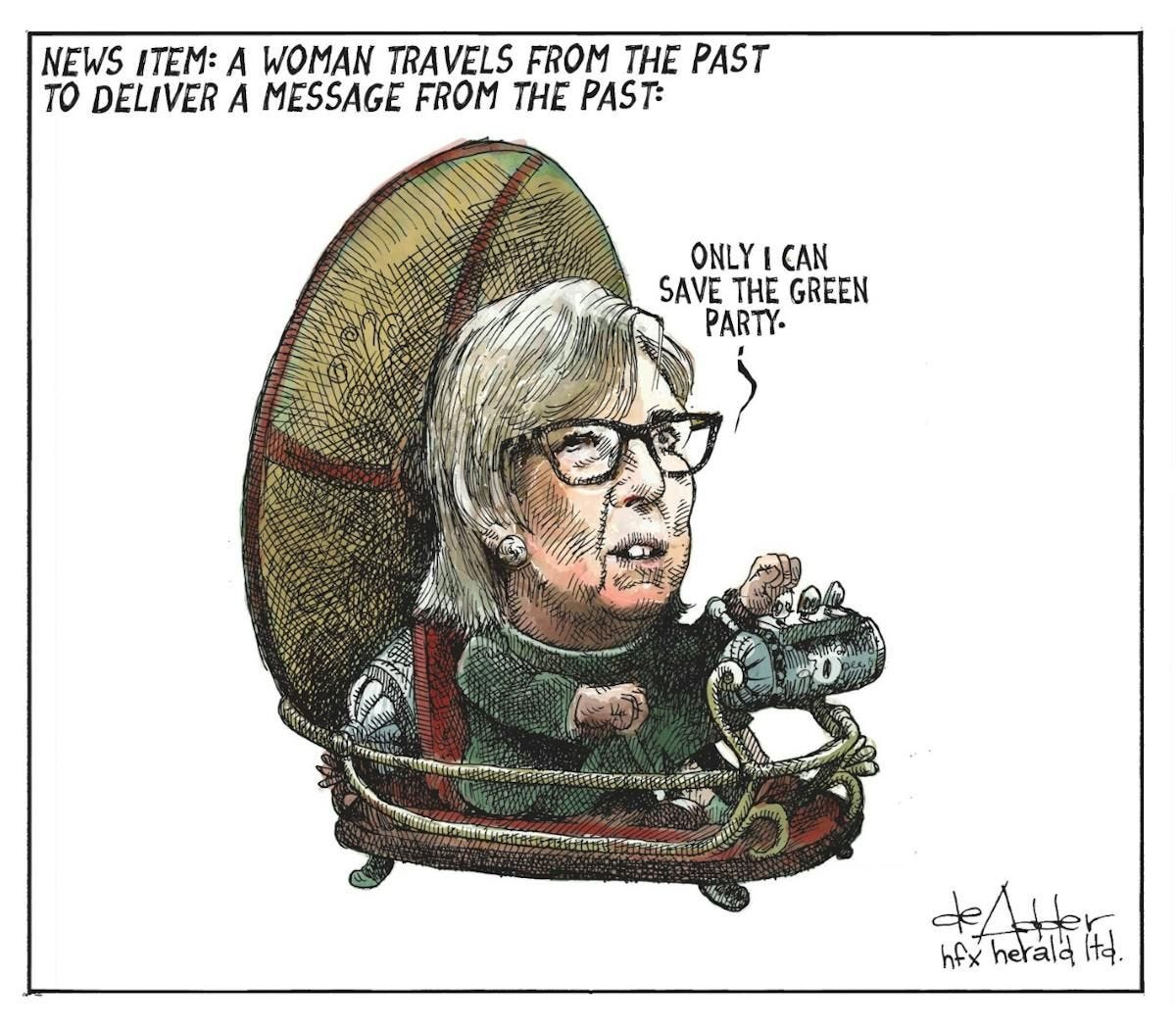
It was only when the financial disclosures came out that the model showed a significant shift — while the May-Pedneault team raised more money, our campaign had more donors, who were also more spread out across the country. Applying similar weighting to the donation numbers as I did search interest shifted the projection and showed a much more competitive race than people expected.
This time, rather than just setting up the model and waiting for the end, I updated a chart daily with the numbers so I could see shifts throughout the race.
As much as I would like to say the model improved, on an individual candidate level it performed worse than in 2020.
The model underestimated May and Keenan, and overestimated Pedneault and Walcott. Part of this could be explained by May fundraising for her co-leadership partner and boosting Pedneault’s numbers, when those donations realistically should have been attributed to her. A similar dynamic played out with our campaign, where people may have voted for Keenan as their first choice even if they supported Walcott. In fact, the co-leadership dynamics seem to have been the main piece I missed in Version 2.
When taken together, I overestimated the May-Pedneault ticket by 5%, and correctly predicted our own result to the second decimal point. This also means when the first ballot was posted at the results event, I knew immediately we had lost.
And now here we are
The BC Green leadership race kicked off at the beginning of July, with Jonathan Kerr launching his campaign. Emily Lowan announced the next day, but the party did not post her announcement on their website until the next week, so Kerr enjoyed a weekend of being the focus of attention. I fired up my model and started tracking, already knowing Bremner-Akins would enter the race because someone kept editing Wikipedia to try to add him as a potential candidate.
However, there are significant flaws in my model this time around. Because candidates announced so late in the year, and the party set a short timeline to prevent anyone signing up new members, there is unlikely to be any financial data available until after the race is over. The race takes place entirely within the third quarter of the year, so we will not see fundraising numbers for the three candidates until November.
To compensate, I have tried to enhance the other metrics. Social media following has been expanded to include personal Facebook profiles, LinkedIn, TikTok, and Bluesky. On pretty much all social media platforms, Lowan has the strongest presence. The only place where she does not have the highest follower count is her Facebook page, which lags slightly behind Kerr’s. However, she has far more friends on her personal Facebook profile.
The bonus points are tougher as well, since only Bremner-Akins has run in any previous provincial election. He receives all of those bonus points. I added a separate line for having run municipally, but on that front only Kerr has run before, so all those points go to him. I don’t have a clean way to weight the two metrics between them, since it’s an apples-to-oranges comparison.
That leaves Google search interest as the most dynamic metric. That is, if anyone is even looking up the candidates.
So this time around my model is missing almost half of the data I need, has few candidates with little profile, and seems to have engaged almost no one. Plus I have no special insight into membership numbers or distribution, and the party seems confused as to how many new people have even signed up.
Still, I have been tracking the race and marking where the numbers are most days. With all the many caveats and flaws in my data, here is what the race (maybe) looks like:

Kerr’s day-one advantage evaporated almost immediately, and Lowan has been holding the lead the rest of the way through. She seems to be the one who is engaging the most people, particularly online, and frequently the only one who registers any search interest whatsoever. While the numbers jump around quite a bit, the trend has been in her favour.
Does this mean she will win? I don’t know. My projections have been fairly accurate before, but the BC Greens structured this race in a way that thwarts my model in several ways. It’s possible these numbers are way off. I will only find out on September 24th, when the results are announced.
Then I will tweak the model again, and get it ready for the next leadership race.
PS. If you want to hear more about the BC Green leadership race, I co-hosted Politicoast two weeks ago and we talked quite a bit about it. Check it out!


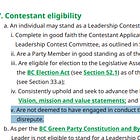

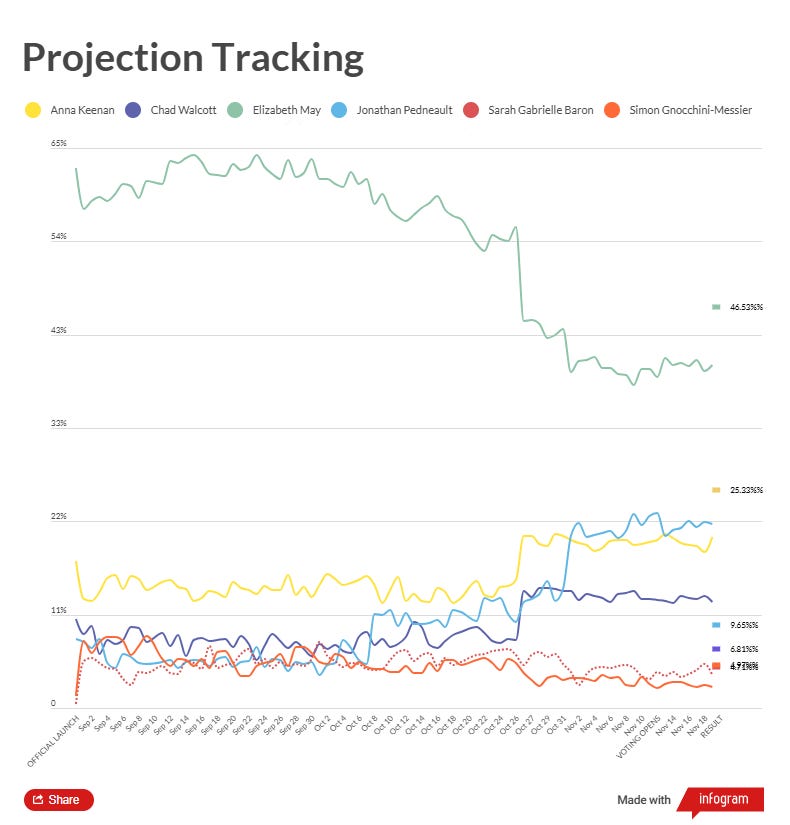
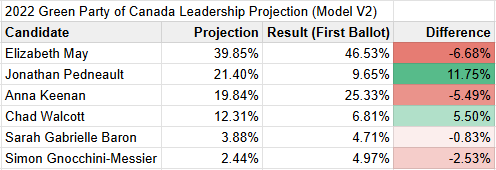
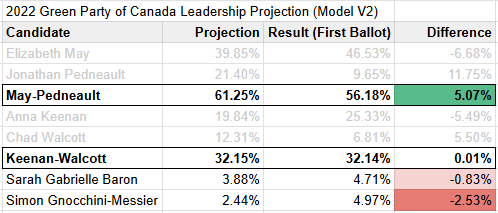

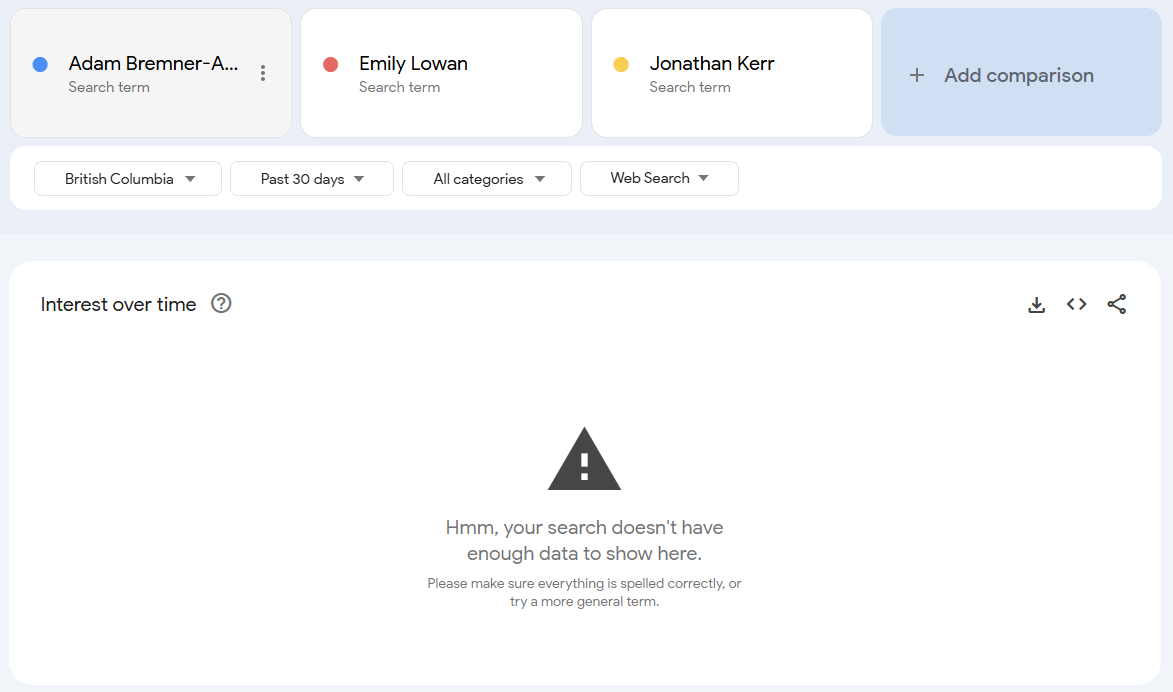
I really appreciate the thought and effort you put into your modelling. When I heard that Emily Lowan had some of the same team behind as Anjali Appadurai - the person who I suspect was about to be elected BC NDP leader before the party rewrote their rule book mid-campaign - I knew almost nothing about her or either of the other candidates and was sure Emily was a lock. Funniest line in your piece... "and the party set a short timeline to prevent anyone signing up new members" with the strikethrough (which I'm not able to replicate in comments). Thing is... I suspect Emily signed up more than enough new members and that the rules/fees around memberships for young members gave both young candidates a huge edge over Jonathan Kerr. Emily also has impressive and surprising endorsements and came off reallllllly well in the online all-candidates event.